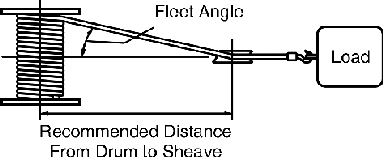Select Your Country/Region
Current Region:
 Global (EN)
Global (EN)
Choose a different country or region to see the content specific to your location
How can we help you?
Total Drum Storage Capacity: Maximum length of wire rope that can be tightly and evenly wound onto a drum. Length is calculated to the top of the drum flange minus selected freeboard (i.e. clearance) . If "Full drum" is selected under Freeboard options then the length is calculated to the top of the flange without any freeboard, The (3) dead (anchoring) wraps are included in all outputs.
Total Working Drum Capacity: Maximum length of wire rope that can be tightly and evenly wound onto a drum, Dead wraps are not included in these outputs since these wraps must remain on the drum at all times.
Recommended Working Capacity: An approximate number equal to 80% of Total Working Drum Capacity. This is a real world estimate of what can be expected due to less than perfect winding practices. Dead wraps are not included in these outputs since these wraps must remain on the drum at all times.

Dead Wraps: The first few wraps of the wire rope around the drum (commonly known as the "dead wraps") provide a simple and secure method of anchoring the wire rope to the drum. This (anchoring) is accomplished by the friction (of the dead wraps) tightening against the drum barrel, as a load is applied. As the load on the wire rope increases so does the anchoring effect. It is critical that the recommended number of dead wraps remain on the drum at all times in order for the load to be held. The number of dead wraps varies according to what prevailing agency or regulatory body’s rules are followed. In the United States, Ingersoll Rand exceeds ANSI / ASME B30.7 (BASE MOUNTED DRUM HOISTS) by recommending that a minimum of (3) dead wraps are kept on the drum at all times.
(Note: Because of the dead wraps the amount of usable wire rope on the 1st layer is diminished slightly. This has been factored into each of the drum calculator outputs.
Freeboard: Freeboard is the amount of space from the top layer of the wire rope to the outside of the drum flange ("D" in fig. 1).
A given amount of freeboard is maintained to prevent the wire rope from inadvertently coming off the drum during use. The amount of freeboard is dependent upon the prevailing agency or regulatory body. In the United States, Ingersoll Rand follows ANSI / ASME B30.7 (BASE MOUNTED DRUM HOISTS) which recommends a minimum of ½" of freeboard be maintained. For your convenience the freeboard selection box allows you to choose various options or input your own requirements.

Freeboard Standards page
Note: The one exception to this is Full Drum Storage. When the winch is not being used to move a load, the wire rope may be spooled to the top of the flange. This practice is for storage purposes only and not recommended when the winch is being used under a load.
Fleet Angle: Fleet Angle is the angle between two lines; the 1st line (Fig 39, "a") drawn from the center of the fixed sheave to the drum (perpendicular to the drum axis). The second lines (Fig. 39, "b") are drawn from the center of the fixed sheave to the drum flanges. In order to promote proper spooling of the wire rope it is recommended that a fleet angle of 1 / 2 to 1- 1 / 2 ° for a smooth drum, and 1 / 2 to 2° for a grooved drum, be maintained. Exceeding these recommendations may cause poor spooling from rope piling up, and possible damage to the wire rope through crushing and abrasion.
